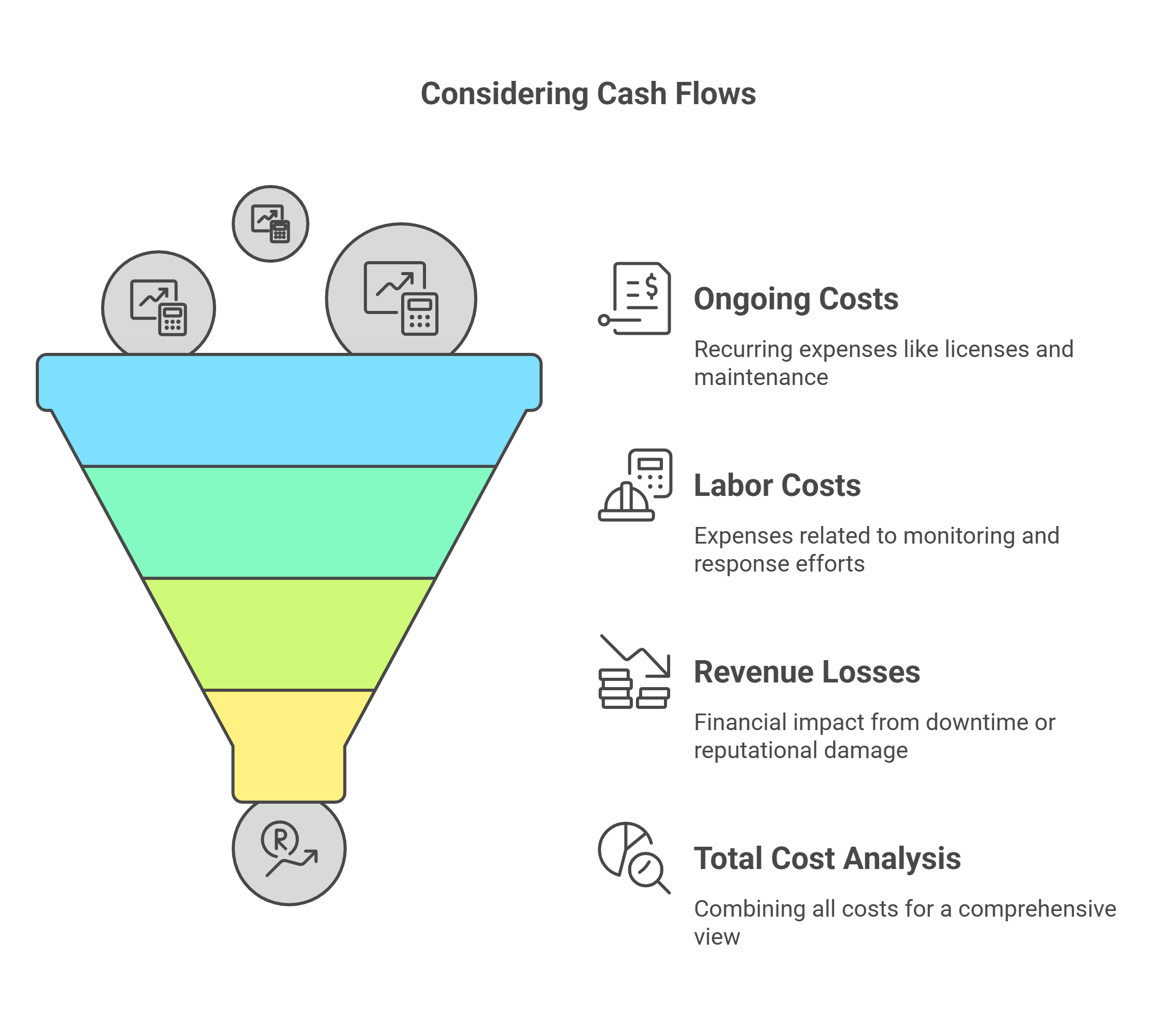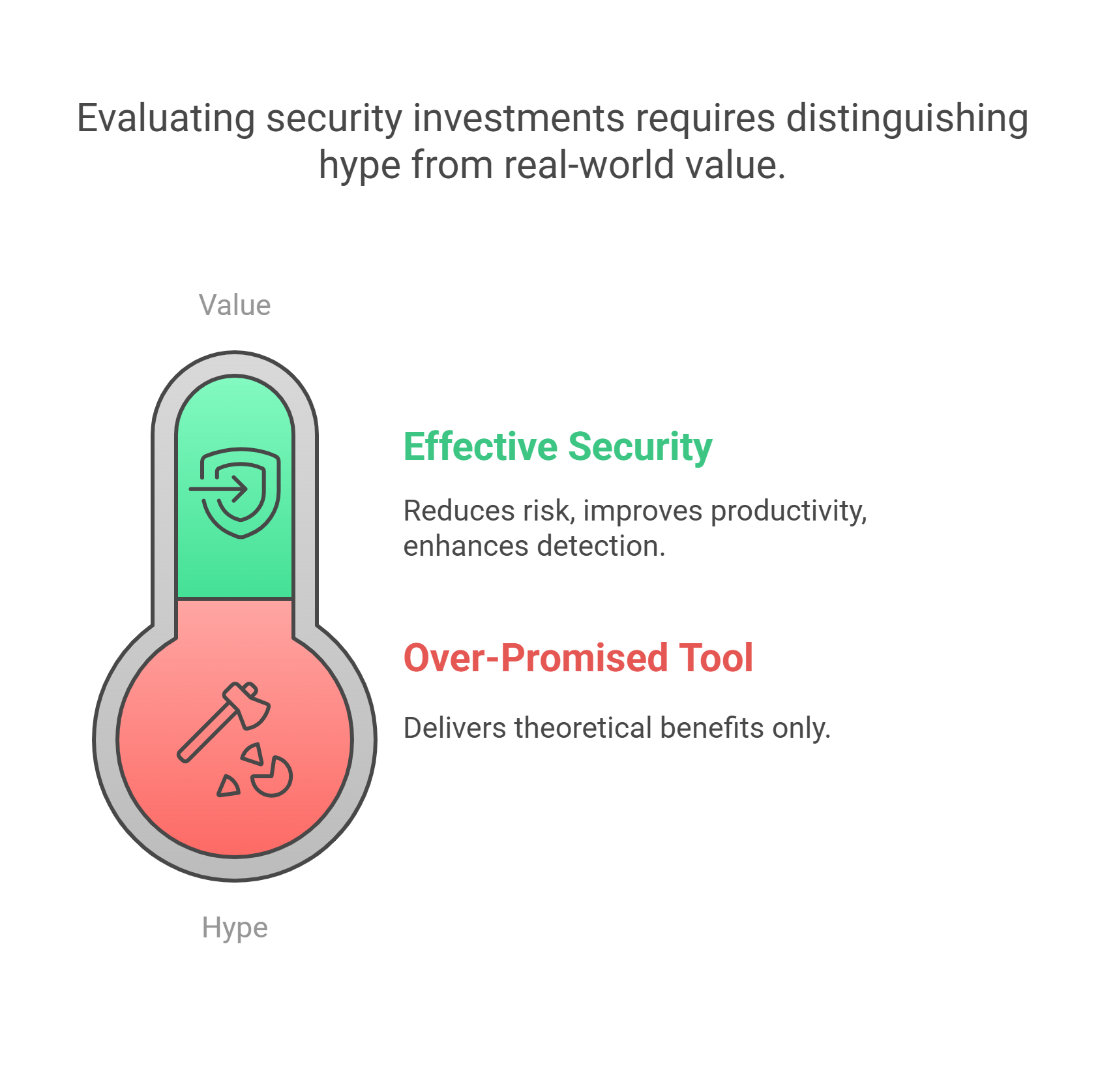
Cybersecurity ROI Calculator: How to Choose the Right Security Tools for Your Project
Cybersecurity ROI Calculator: How to Choose the Right Security Tools for Your Project
CISOs, IT Managers, and Board members face a tough balancing act when building out strong security programs—and calculating ROI is a big part of the challenge. What security solution is truly worth the investment compared to the potential cost of a damaging cyber attack?
A cybersecurity ROI calculator helps assess profitability, making it easier to weigh the value of various investments. The risks are real: by some estimates, cybercrime could cost $1.2–$1.5 trillion annually by the end of 2025.
Effective data protection measures can significantly enhance operational stability and regulatory compliance. A strong cybersecurity strategy is not just IT hygiene - it’s a business risk strategy. With rising regulatory pressure and compliance standards like GDPR, Boards are now leaning on CISOs and IT leaders for direction. The challenge: sorting through a flood of tools and aligning them with business objectives. That’s where ROI analysis becomes essential - connecting security spending with measurable business value.
Introduction to Cybersecurity Investments

Cybersecurity investments are fundamental to protecting organizations from breaches and threats. While upfront costs can be significant, the long-term returns often outweigh the risks, leading to substantial financial gains.
Calculating ROI helps organizations make informed decisions by comparing expected benefits with potential costs, such as downtime, recovery, or reputational damage. It also accounts for ongoing expenses like tool maintenance and updates. Additionally, measurable improvements in cybersecurity performance are crucial in building and maintaining customer trust, as consumers are increasingly concerned about how companies handle their sensitive data.
The ROI formula is simple - but cybersecurity ROI is not. It requires factoring in unique variables like alert fatigue, human resources, and breach probabilities. Still, understanding ROI is crucial to justify security budgets and guide smart investments.
Understanding Return on Investment

Return on investment (ROI) is a core metric in financial decision-making. It helps evaluate whether a particular investment - cybersecurity or otherwise - is delivering value by using ROI calculations.
To calculate ROI: ROI = (Net Profit / Investment Cost) x 100
This allows CISOs and Boards to compare different initiatives and determine which yield the highest return. Presenting ROI figures is pivotal for CISOs and security leaders to effectively communicate the financial and strategic implications of cybersecurity investments to the Board. Whether choosing between EDR solutions or broader managed services, ROI provides a consistent way to benchmark.
Calculating ROI for Cybersecurity

A common approach to cybersecurity ROI is to estimate the average cost of a security breach, then multiply that by the expected frequency. That gives a risk-adjusted baseline. From there, you can compare it to the cost of prevention tools or services.
But it’s not just about dollars. Intellectual property loss, reputational damage, and operational downtime are harder to quantify but still critical. This complexity makes cybersecurity ROI notoriously challenging - but also essential.
Investing in robust cybersecurity measures impacts the overall value of a system and its attractiveness as a target for attackers.
If you’re looking for a deeper dive, How to Measure Anything in Cybersecurity Risk by Douglas Hubbard and Richard Seiersen is an excellent resource.
Bottom line: ROI conversations allow security leaders to weigh prevention costs against the potential fallout from a breach.
Identifying Cybersecurity Metrics

False Alerts vs. Positive Alerts
False positives aren’t just noisy - they’re expensive. According to the Ponemon Institute, they cost enterprises over $1.3 million in lost revenue annually. If you’re not tracking this, you may be ignoring a six-to-seven-figure problem.
These alerts consume time, create alert fatigue, and lead to missed real threats. Every unnecessary investigation represents a hidden cost.
Critical Alerts
Unlike false positives, critical alerts often fall into the “priceless” category - but they aren’t free either. The IBM Cost of a Data Breach Report 2024 notes that it takes an average of 292 days to identify and contain a breach. During that time, opportunity costs and remediation costs stack up.
Understanding the cost of delay in addressing critical alerts is essential when assessing tool performance and ROI.
Cost Efficiencies: Moving from False to Critical Alerts
What does it cost your team to investigate a false alert? What’s the ROI of automation that filters these out?
Conversely, how effective - and cost-efficient - are your incident response protocols for true critical threats?
Answering these questions with real data is foundational to understanding your return on cybersecurity investments.
Considering Cash Flows

Cash flow analysis is an often-overlooked part of ROI in cybersecurity. It’s not just about upfront tool costs—it’s about ongoing financial impact, including implementation costs.
Your ROI model should account for:
Ongoing license or maintenance costs
Labor required for monitoring and response
Revenue losses from downtime or reputational damage
Additionally, considering the total cost of cybersecurity investments, including all associated expenses, helps organizations prioritize their security solutions based on comprehensive cost analysis.
Annualized ROI helps paint a clearer picture by showing value over time. Factoring in the time value of money helps CISOs and CFOs alike make more informed investment decisions.
Negative ROI

Sometimes, the math doesn’t work out. A negative ROI reveals that an investment is costing more than it returns, impacting the actual ROI.
In cybersecurity, this might result from high support costs, ineffective tools, or insufficient risk reduction. Recognizing negative ROI early allows you to pivot and reallocate budget where it matters most. Understanding the initial cost is critical in determining the Payback Period for investments, as it helps compare initial expenditures against the benefits and savings generated over time.
Where to Find ROI Calculator for Cybersecurity

Not all ROI calculators are created equal. Some are too simplistic, others too complex, making accurate ROI calculation challenging.
The CyVent Cybersecurity ROI Calculator is designed with executive decision-makers in mind. It integrates real-world inputs - like false-positive rates and alert resolution costs - to deliver actionable insights.
Understanding the ROI equation is crucial for assessing potential returns from investments and making comparisons between options. Rather than generic estimates, you get tailored results that reflect your industry, security maturity, and alert landscape.
The Benefits of Calculating Cybersecurity ROI

The benefits go far beyond budget justification and cost avoidance. Calculating ROI allows you to:
Align security investments with business goals
Justify budget requests to the Board
Benchmark tool effectiveness over time
Prioritize spending where it has the most impact
Highlighting the high ROI of cybersecurity investments not only contributes to overall business value but also aids in securing additional resources for development.
According to IBM, the average cost of a data breach hit $4.88 million in 2024, a 10% jump from the prior year. In response, 51% of companies plan to increase their security budgets - with investments in incident response planning, training, and advanced detection tools.
Understanding the Value of Cyber Tools

With endless new products flooding the market, CISOs must determine which options represent the better investment by separating hype from value.
Calculating ROI brings structure to vendor evaluations. It allows security leaders to assess which tools offer real-world value in reducing risk, improving productivity, or enhancing detection. Additionally, implementing and communicating effective security measures within organizations is crucial to managing cyber risks and preventing financial losses.
Evaluating and Prioritizing Security Solutions for Risk Management

Not all investments are created equal. Some tools offer higher ROI based on risk reduction, ease of deployment, or long-term cost savings.
Understanding the return on security investment (ROSI) is crucial. This metric helps organizations quantify the benefits derived from their security expenditures, particularly in relation to avoided losses from security incidents.
By using ROI as a framework, security teams can:
Prioritize the most impactful tools
Eliminate redundant or underperforming solutions
Justify new investments with confidence
Achieving Peace of Mind and Problem Resolution

Cybersecurity is about more than defense—it’s about peace of mind and minimizing operational disruption.
Calculating ROI enables security leaders to articulate how a specific solution addresses a specific risk - and what level of certainty or stability it offers in return. By factoring in net income, organizations can better measure the profitability of their cybersecurity investments in comparison to the associated costs.
This approach transforms security from a cost center into a value generator.
Communicating Cyber Risk to the Board

Translating technical risks into business terms, including the risks of cybersecurity breaches, is one of a CISO’s greatest challenges.
ROI is a universal language in the boardroom. Presenting clear, quantified metrics allows Boards to understand:
Financial exposure
Strategic risks
Budget trade-offs
Introducing the ROI metric is crucial as it helps gauge business profitability by measuring total returns and costs accurately.
It also builds trust in security leadership and helps justify further investment in people, processes, or platforms.
Aligning Cybersecurity with Overall Business Strategy

Cybersecurity investment isn’t just a math exercise—it’s a way to connect cybersecurity with business performance.
When CISOs quantify how a tool protects revenue, enhances resilience, or supports compliance, they’re better positioned to align with broader strategy. Evaluating cybersecurity investments also involves considering operational efficiency, enabling organizations to prioritize initiatives that align with business objectives and improve cost management. The result? Faster buy-in, clearer budgeting, and more strategic decisions.
Embracing Security Tools with Proven ROI

The Importance of a Layered Security Approach
Not all layers in a security stack are created equal. It’s not just about adding more tools - it’s about building intelligent layers that communicate, adapt, and evolve together from their initial value.
Implementing effective security measures is crucial for managing cyber risks and preventing financial losses. Security leaders must articulate the value of these measures to top executives and ensure proper budgeting for both physical and cybersecurity protocols.
Understanding the capital costs of each layer helps security teams evaluate true ROI and avoid redundancy.
Recent Advancements in Cybersecurity Technology
New technologies like AI-powered detection, behavioral analytics, and predictive modeling are proving their value in addressing emerging threats. They reduce dwell time, cut incident costs, and improve detection rates - delivering measurable ROI.
In the context of cybersecurity today, leveraging advanced technologies such as AI is crucial. Proactive measures and intelligent systems are essential to outsmart potential attackers as the digital environment continues to change.
The Power of Cybersecurity Artificial Intelligence

AI for Incident Reduction
Organizations using AI-driven security automation save an average of $2.2 million per breach. Predictive analytics reduces response time and prevents damage - often before it starts.
AI vs. AI: Staying Ahead of Attackers
Threat actors are already using AI. Your defenses must be smarter, faster, and more adaptive. The real ROI lies in outsmarting attackers before they gain access.
The Efficiency of Automation

Streamlining Incident Management
Automation doesn’t replace your team - it enhances it. By eliminating repetitive tasks, security staff can focus on complex threats that require human judgment.
Boosting Productivity in IT Teams
Freeing up analyst time creates strategic ROI. Instead of chasing false positives, teams can work on long-term improvements, training, and innovation.
Reach Out to Our Team
The cybersecurity landscape is complex and evolving fast. At CyVent, we help CISOs and security teams evaluate, prioritize, and deploy solutions that drive real business value through an effective marketing program.
Our Cybersecurity ROI Calculator is one of the many tools we’ve developed to make this easier. Determining which security solution represents the better investment is crucial for maximizing your ROI.
Let’s talk. Whether you’re starting from scratch or refining your current strategy, we’re here to help you navigate the market, select the right tools, and show measurable results.
Contact our team today for personalized cybersecurity advisory services.


